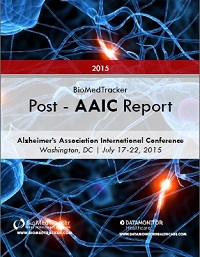Report Library
All Reports
2015 BioMedTracker Post-AAIC Report
September 25, 2015
The Alzheimer’s Association International Conference (AAIC) was held in Washington, DC from July 17-22, 2015. This year’s meeting
featured both clinical data from drugs in development for symptomatic treatment and details of the continuing clinical efforts to identify
effective disease-modifying therapies for Alzheimer's Disease. There was renewed energy around amyloid targeted therapies and
increased interest in tau-targeted therapies now that tau PET imaging agents have matured to measure target engagement.
We have included a comprehensive list of oral and poster presentations that were added to BioMedTracker from the meeting with analyses and expert opinions. Additionally, we have provided a list of upcoming large-impact and data catalysts for Alzheimer’s Disease.
KEY HIGHLIGHTS
For our disclosures, please read the BioMedTracker Research Standards.
We have included a comprehensive list of oral and poster presentations that were added to BioMedTracker from the meeting with analyses and expert opinions. Additionally, we have provided a list of upcoming large-impact and data catalysts for Alzheimer’s Disease.
KEY HIGHLIGHTS
- Updated Phase Ib PRIME results showed that aducanumab (BIIB) failed to meet MMSE and CDR-SB endpoints with the 6mg dose, but it did significantly reduce the amyloid plaques. The overall dose-dependent effect of the amyloid beta antibody was significant, and two global Phase III trials, EMERGE and ENGAGE, were initiated in early Alzheimer’s Disease.
- Results from solanezumab (LLY) EXPEDITION EXT, an extension trial of EXPEDITION and EXPEDITION 2, showed that the compound has a small, potentially disease-modifying effect using a delayed-start design. However, given that the pivotal trials failed to show significant effects of the amyloid beta antibody, only positive EXPEDITION 3 results can be the key driver of success for solanezumab. Top-line results from EXPEDITION 3 are expected in Q4 2016.
- Top-line results for a Phase IIb trial of RVT-101 (AXON) showed a significant benefit in mild to moderate AD patients as an adjuvant to donepezil. We expect that the 5-HT6 receptor antagonist will have a similar shot on goal as LuAE58054 (HLUKF), however the overall symptomatic effects of this mechanism are fairly modest.
- Tau therapies garnered a fair share of attention as PET imaging agents are now mature enough to detect target engagement. We expect increased interest in tau targeted therapies including those presented at this year’s meeting, Tau ASO (ISIS) and AADvac1 (Axon Therapeutics).
For our disclosures, please read the BioMedTracker Research Standards.
| Indications Covered: |
Alzheimer's Disease (AD)
Alzheimer's Disease - Imaging |
Additional Resources:
